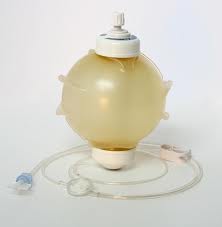Elastomeric Pump

Elastomeric pumps, also known as balloon pumps, find common usage in the
medical sector for administering liquid medications such as local
anesthetics, cytostatics, or antibiotics, depending on the therapy required.
The pressure needed to deliver the medication stems from the elastomeric
layer contained within the pump. As the pump is filled, this layer undergoes
stretching. The elastic constriction propels the liquid through the tubing
and eventually out through a flow restrictor into the patient connection,
maintaining consistent pressure until nearing the end of the infusion, where
a pressure spike typically occurs, resulting in a higher flow rate.
Control over the flow rate's accuracy is ensured by a flow restrictor, which
may be a glass capillary or steel cannula integrated into the tubing system
or positioned within the elastomeric reservoir. Elastomeric pumps operate
without electricity and are not gravity-driven. Placing the pump above or
below the patient can slightly increase or decrease the flow rate (known as
the head height effect). Manual filling of the pump is achieved through a
one-way valve using a syringe or peristaltic repeater pump. These pumps are
renowned for their reliability and precise flow rate.
Elastomeric pumps require no maintenance and function autonomously without
any electronic components, typically being disposed of after single use.
Depending on the pump's size, the medication within can be dispensed over a
duration ranging from one to seven days.
These pumps are particularly suited for outpatient settings or patients
requiring a high level of mobility.
undo Medical Equipment